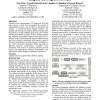Free Online Productivity Tools
i2Speak
i2Symbol
i2OCR
iTex2Img
iWeb2Print
iWeb2Shot
i2Type
iPdf2Split
iPdf2Merge
i2Bopomofo
i2Arabic
i2Style
i2Image
i2PDF
iLatex2Rtf
Sci2ools
TEI
2009
ACM
2009
ACM
The effect of representation location on interaction in a tangible learning environment
Drawing on the ‘representation’ TUI framework [21], this paper reports a study that investigated the concept of ‘representation location’ and its effect on interaction and learning. A reacTIVision-based tangible interface was designed and developed to support children learning about the behaviour of light. Children aged eleven years worked with the environment in groups of three. Findings suggest that different representation locations lend themselves to t levels of abstraction and engender different forms and levels of activity, particularly with respect to speed of dynamics and differences in group awareness. Furthermore, the studies illustrated interaction effects according to different physical correspondence metaphors used, particularly with respect to combining familiar physical objects with digital–based table-top representation. The implications of these findings for learning are discussed. Keywords Tangible interface, representation, children, learning.
Hardware | Keywords Tangible Interface | ReacTIVision-based Tangible Interface | Tangible Interface | TEI 2009 |
| Added | 19 May 2010 |
| Updated | 19 May 2010 |
| Type | Conference |
| Year | 2009 |
| Where | TEI |
| Authors | Sara Price, Taciana Pontual Falcão, Jennifer G. Sheridan, George Roussos |
Comments (0)

